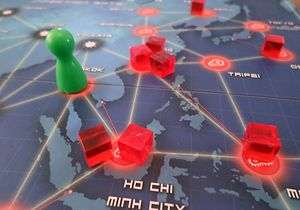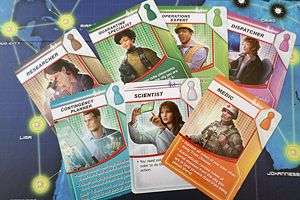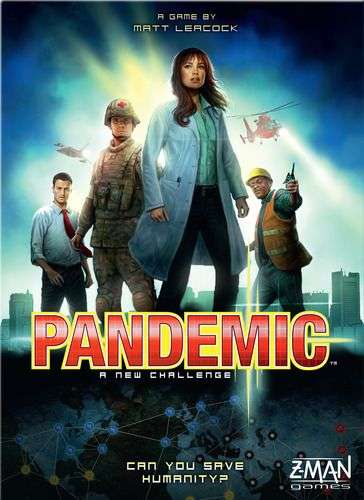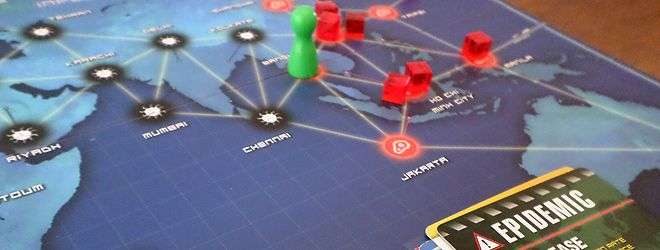Acoustic Gaming: Pandemic – Review
by Ste
|
 Getting ill sucks balls. Oozing pus, coughing up lungs, explosive diarrhoea. No thanks; I decided a long time ago that I’d just man up and stop getting ill. So far my bravado and testosterone combination is working, and I’m still alive. That rash down there? Ha, that’s never going away, so let’s stop talking about that.
Getting ill sucks balls. Oozing pus, coughing up lungs, explosive diarrhoea. No thanks; I decided a long time ago that I’d just man up and stop getting ill. So far my bravado and testosterone combination is working, and I’m still alive. That rash down there? Ha, that’s never going away, so let’s stop talking about that.
Pandemic is a board game designed by Matt Leacock, currently in its second edition, and published by Z-Man Games. Set in the modern-day world, two to four players must work together to find a cure for four deadly diseases which are spreading quickly across the world, killing people at an alarming rate.
Players begin by randomly selecting one of seven role cards. Each role has its own unique ability which must be combined with the roles of others in order to win. For example, the Scientist can find cures quicker, while the Medic is better at healing people, and the Quarantine Specialist can prevent disease from spreading to and from the cities around them.
The board is then set up and cities are randomly infected with diseases by drawing cards from the infection deck. Cards are then drawn from the Player deck, the number of which depends on how many are playing. The fewer players there are the more cards you get. There are three types of player cards: City cards, which come in four colours that correspond to the four diseases; Event cards, which help the players by giving them special abilities – Air Lift, for example, can transport any player to any other city in the world – and the final type of player card is the Epidemic card. This one is bad and I’ll go into more detail on that one later.
Once set up is complete, players take turns to carry out four of the following actions in any combination:
- Move in one of four ways: to connecting cities, between research stations, by discarding city cards in your hand to travel there, or by discarding the city card which matches your current city to travel elsewhere.
- Cure one disease cube from the city you are in. (Medics can cure three cubes as one action)
- Exchange Knowledge: Give or take a city card from another player. You both must be in the city named on the card you are swapping (unless you are a Researcher)
- Cure a disease by discarding five city cards of the corresponding disease colour. (The Scientist only needs four cards)
- Place a Research Centre by being in that city and discarding its corresponding card.
 At the end of each player’s turn they take two cards from the Player deck and infect more cities on the board by drawing from the Infection deck. If you run out of Player cards, you lose. Hidden within the Player deck are Epidemic cards, which have the sole purpose in life of fucking up your day. Every time one is drawn the following things happen: first, the rate increases on the Infection track, which corresponds with the number of cards that are drawn in the Infect Cities stage. Then the bottom card from the Infection deck is taken and three disease cubes of the corresponding colour are added to that city on the board.
At the end of each player’s turn they take two cards from the Player deck and infect more cities on the board by drawing from the Infection deck. If you run out of Player cards, you lose. Hidden within the Player deck are Epidemic cards, which have the sole purpose in life of fucking up your day. Every time one is drawn the following things happen: first, the rate increases on the Infection track, which corresponds with the number of cards that are drawn in the Infect Cities stage. Then the bottom card from the Infection deck is taken and three disease cubes of the corresponding colour are added to that city on the board.
This card is then added to the discarded Infection cards before being reshuffled, and added back to top of the Infection deck. This means that cities that just recently had disease cubes placed on them risk having further cubes added by other players. This doesn’t sound too bad, but each city can only hold three cubes of each colour, so if any more are added an outbreak occurs and all connecting cities have a cube of that colour added to them. This means that there is the possibility of chain reactions of outbreaks occurring across the board. If you reach eight outbreaks, it’s game over.
The players have to juggle trying to find cures with keeping the various diseases from running out of control. They are encouraged to discuss their options and help to plan each other’s moves in advance, and it’s surprising how much you care about someone else’s move rather than just concentrating on what you need to do yourself. One problem I have found about this type of gameplay, however, is that one player inevitably turns into the “Alpha player” – that person who tells other people where to go and what to do. Despite my best efforts, this has often been me, but even when I force myself not to, someone else will normally adopt the role. However, if you can get a good group together who don’t just sit back and let others make decisions for them it makes for a more interesting game. Admittedly the co-operative nature of the game won’t be for everyone. Despite how refreshing this is to me, some people just like to win and then be able to gloat over it. The board game doesn’t sulk when it loses, and some people won’t like that.
 In terms of components, Pandemic is very good. The cards are of a high quality and get across the required information without the need to hunt around a load of text. As for the board itself, it too is very well designed with everything clearly laid out. Z-Man Games, the publisher, have also done a great job with the instruction booklet, and have even produced a YouTube video to teach you how to play the game if you can’t be arsed to read the booklet to your friends. My only bugbears are the player token and the disease cubes which are plastic and, in my opinion, have a cheap feel to them. Apparently in the previous edition these were both made out of wood, which sounds much better.
In terms of components, Pandemic is very good. The cards are of a high quality and get across the required information without the need to hunt around a load of text. As for the board itself, it too is very well designed with everything clearly laid out. Z-Man Games, the publisher, have also done a great job with the instruction booklet, and have even produced a YouTube video to teach you how to play the game if you can’t be arsed to read the booklet to your friends. My only bugbears are the player token and the disease cubes which are plastic and, in my opinion, have a cheap feel to them. Apparently in the previous edition these were both made out of wood, which sounds much better.
In the replayability stakes, Pandemic has it in spades. To start with, the seven different roles means there are a few combinations that four players can end up with, which often leads to varying styles of gameplay. On top of this, the difficulty of the game can be increased by adding more Epidemic cards. The “normal” difficulty uses four cards but the box comes with six. However, if I’m entirely honest, I’ve yet to win a five or six Epidemic card game with more than four people, so perhaps you can argue that this makes the game too hard? Maybe my group and I are just shit? Who knows.
 |
 |
 |
 |
 |
 |
If you get to the point that the core game is becoming too easy or stale there are currently three expansions available to buy, each of which add further features and game modes to the mix. Be warned though, from what I understand the expansions need to be purchased in order as they make use of features only available in previous expansions. Please check out the requirements before making your purchase.
If you are like me and thought that board gaming didn’t extend past Monopoly, Cluedo, and Guess Fucking Who, and you fancy dipping your toe into the modern board gaming experience then Pandemic is a bloody good place to start. It’s not the simplest game to get your head around, but once it clicks that you’ve all got to work together to win, the game begins to shine. I really shouldn’t be feeling as much suspense as I do when playing this. It difficult to describe, especially towards the end of the game, when you’re just a few moves away from finding the last cure but only one outbreak away from doom, it’s brilliant. If you ever get chance to play it, I thoroughly recommend you give it a try.
Pros- Co-operative style of play is refreshing
- Good quality components overall
- Loads of replayability
- Great fun even when you lose
- Even fucking better when you win!
- Co-operative style of play isn’t for everyone
- Alpha gamer syndrome can be a problem
- Higher difficulties are hard as nails
Pandemic is a great game, despite its non-competitive style of play, I’ve never had so much fun losing a game than I have with Pandemic. The surprisingly suspenseful gameplay is more than worth the relatively modest £25 or so you’ll pay to own it. With plenty of replayability and expansions to try out too, Pandemic will keep finding its way back your table for a long time to come.
Last five articles by Ste
- Acoustic Gaming: X-Wing Miniatures Game - Review
- Acoustic Gaming: Pandemic Legacy – Season One
- Bored Gaming
- U Wot Mate?
- Tabletop Simulator - Review


























An excellent game and my favourite in a collection of around fifteen.
I play this at least twice a week with the other half and the expansions only add to an already solid premise. We’ve managed to win with five cards and most of our games are now played with five cards but I think the game is slightly easier with two people because you start with four cards. Sometimes that’s a blessing and sometimes a curse.
Yeah a 5 epidemic card game with 2 players is very doable, I don’t think 6 cards is much harder, but once you start introducing more players it all starts going mental. Our team usually fall into 1 of 2 traps, either we just seem to get stuck putting out proverbial fires and then run out of Player cards, or we try and grab the cures quickly and end up hitting the Epidemic limit. The first time I played a 6 Epidemic card game with 4 players we lost within 3 turns each… Nightmare